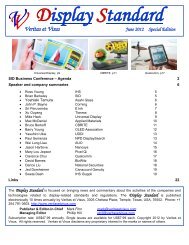You also want an ePaper? Increase the reach of your titles
YUMPU automatically turns print PDFs into web optimized ePapers that Google loves.
<strong>Veritas</strong> <strong>et</strong> <strong>Visus</strong> <strong>Display</strong> <strong>Standard</strong> February 2009<br />
FCC authorizes fix for DTV signal range problems<br />
The Federal Communications Commission has authorized a fix that it hopes will resolve<br />
a potentially big DTV transition glitch: television stations whose digital broadcast area<br />
will be smaller or different than their analog contours. The solution is called a<br />
“distributed transmission system” (DTS), essentially an array of digital transmitters<br />
spread out over the signal area as opposed to a single tower. But Ars Technica reports that the Order doesn’t require<br />
any TV station to use the system. And this rule-making comes pr<strong>et</strong>ty late in the DTV day, shy of February 17, when<br />
all full power stations must switch to digital. Plus, the Commission worries that DTS might lead to broadcaster<br />
practices that, under certain circumstances, could make things worse. The biggest problem that came up during the<br />
FCC’s trial run test of the digital transition in Wilmington, North Carolina in September was that some viewers of<br />
television station WECT lost service, even though they had installed s<strong>et</strong>-top box converters for their analog<br />
receivers. In fact, one third of the help calls that public service agencies got on DTV Day in Wilmington related to<br />
that snafu. WECT’s digital broadcast area is smaller than its old analog contour. http://www.fcc.gov<br />
Golden Signals brings out TV/PC fix<br />
<strong>Display</strong>Share from Golden Signals introduces a use for bringing a PC display to an HDTV, and for listening to PC<br />
music through a home audio system. <strong>Display</strong>Share allows on TV or HDTV an entire PC display, stored pictures<br />
and video, IPTV (Intern<strong>et</strong> Protocol Television), any document, such as Microsoft Word & PowerPoint, and Web<br />
pages. <strong>Display</strong>Share allows you to use home audio speakers to play stored music and Intern<strong>et</strong> radio. <strong>Display</strong>Share<br />
software is now available to support PlayStation 3. http://www.goldensignals.com<br />
ITU releases new standard to wire up the digital home<br />
The International Telecommunication Union (ITU) released a new standard that will enable communications over<br />
phone, power and coaxial cables in the home at up to 700Mbps for the delivery of bandwidth intensive multimedia<br />
content. The new standard ITU-T Recommendation G.9960 is the first in the ITU-T’s G.hn family of standards. It<br />
will enable chip manufacturers to build transceivers that can be incorporated into s<strong>et</strong>-top boxes, residential<br />
gateways, home computers, home audio systems, DVD players, TVs or any other device that might be connected to<br />
a n<strong>et</strong>work now or in the future. According to the ITU, products incorporating these chips could be on the mark<strong>et</strong> as<br />
early as 2010. It quotes Joyce Putscher, principal analyst at mark<strong>et</strong> research firm In-Stat, saying: “Service operators<br />
have been looking for an international standard that encompasses multiple existing-wire mediums for video<br />
distribution. G.hn me<strong>et</strong>s that requirement and it seems clear that with significant industry backing from service<br />
providers, semiconductor and equipment vendors, and the fast rate at which the process is moving to achieve a<br />
standard, we will see first equipment by 2010.” G.9960 focuses on the physical or PHY layer of the<br />
communication. In step with ITU guidelines on new standards development, several power saving modes have been<br />
incorporated. Work is continuing to develop the media access control layer. http://www.itu.int<br />
SiBEAM delivers high-performance WirelessHD chips<strong>et</strong>s in production<br />
SiBEAM announced that its line of WirelessHD chips<strong>et</strong>s has entered volume production.<br />
SiBEAM has provided sample wireless chips<strong>et</strong>s to select customers since the first<br />
quarter of 2008 and is now preparing to broadly expand partners’ product development<br />
activity. Previous technology demonstrations of SiBEAM’s chips<strong>et</strong>s have focused exclusively on wireless video<br />
area n<strong>et</strong>works (WVANs) and audio/video transmission for home entertainment centers. SiBEAM highlighted the<br />
viability of applying the technology for CE applications as well as PC virtual docking applications in the future.<br />
SiBEAM’s chips<strong>et</strong>s with OmniLink60 technology operate in the 60GHz band and represent the world’s first 60<br />
GHz chips<strong>et</strong>s to be developed and produced in CMOS. The SB9120 WirelessHD HRTX Transmit N<strong>et</strong>work<br />
Processor and SB9121 WirelessHD HRRX Receive N<strong>et</strong>work Processor have recently entered mass production and<br />
support uncompressed and lossless wireless delivery of 1080p/60 Full HD deep color video and audio. The chips’<br />
designs enable them to be efficiently embedded into flat panel televisions, s<strong>et</strong>-top boxes, Blu-ray DVD players,<br />
personal computers, laptops, home media gateways and more. http://www.sibeam.com<br />
25






